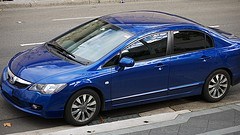Take this free expungement eligibility test to see if you qualify.
How to Expunge or Seal your Nevada Records
Nevada’s record sealing designed to help deserving people be more productive and get more out of life by sealing records of their convictions. Once your Nevada record is sealed you can apply to any job with confidence. Your record will be treated as if it had never occurred. Once your records are sealed, you can honestly tell any employer that you were not convicted of a crime.
Upon expungement in Nevada, your rights to vote, hold office and serve on a jury are restored. To see if you are eligible to have your record expunged, you can contact a lawyer or take a record expungement and record sealing eligibility test free of charge to see if you are able to clear your record at this time.
Was this helpful?
Nevada Criminal Record Sealing of a Crime Against A Child

Sex offender photo by Victor Casale
The law which authorizes a criminal record to be sealed, NRS 179.245, a short list of crimes that are not eligible to be sealed. First on the list is one that often confuses or, worse, often deters a person from applying to have their record sealed is that the crime cannot have been against a child.
A person who does not have legal training may read that requirement and think that someone convicted of child abuse or child neglect would never be eligible to have their record sealed in Nevada. What could be more obvious, both of those crimes by definition are against a child.
Nevada Record Sealing Law Eligibility Is Tricky
Well, this is where some legal training comes in handy. The term crime against a child is not what it seems. That is, it is not what the plain language of it suggests. The term is actually a reference to a list of crimes defined in Nevada law as crimes against a child. NRS 179D.0357 defines crimes against a child as kidnapping, false imprisonment, and sex trafficking involving a victim who is under the age of 18 at the time of the offense. Those are some pretty serious offenses, all of which are felonies. Misdemeanor child neglect and child abuse are a long way away from what is defined as crimes against a child.
So, unless a person was convicted of one of those three offenses, the prohibition against sealing a record where the victim was child does not apply. This nuance in language and law is a perfect example of why it is important to consult a lawyer when considering anything involving the law. I am sure many well meaning people have misread the law and given bad advice or taken their own bad advice.
Sexual Offense Waiting Periods Before Sealing
Of course, there are other requirements, most notably are the waiting periods, which start after the sentence, including probation or parole, are complete. 15 years for Category A or B felonies. 12 years for category C or D felonies. 7 years for category E felonies, gross misdemeanors and misdemeanor DUIs. 2 years for misdemeanors. There is no waiting period for arrests without conviction after dismissal or acquittal.
Hit-and-Run Accident in Nevada and Criminal Charges
According to a report by CNN morning show, New Day, an elderly man at a gas station in Las Vegas become the victim of a hit-and-run when a driver deliberately hit the gentleman and continued to speed-off away from the scene. The question seems to be, was this an accident, or was the incident intentional, and, in which case, attempted manslaughter. Investigators have turned to YouTube in hopes that someone will be able to identify the Honda Civic on camera. For everyone else, this could be the perfect opportunity to investigate the terms and penalties of Nevada’s hit-and-run laws.

Similar Honda Civic involved in hit and run.
Photo by Highway Patrol Images
What Constitutes as a Hit-and-Run in Nevada
The phrase ‘hit-and-run’ is most often associated with a person in a vehicle assaulting a pedestrian by hitting the pedestrian with the vehicle. The actual definition of a hit-and-run is actually much broader. According to Webster’s definition, a hit-and-run is “denoting a motor accident in which the vehicle or vessel involved does not stop, or a driver, victim, vessel, etc., involved in such an accident: a hit-and-run by boating accident / a man on a bicycle had been struck and killed by a hit-and-run driver.” It is important to note that a hit-and-run can occur regardless of whether or not the vehicle is a car or another form of motor vehicle.
NRS 484E.010 Terms and Penalties
The legal definition of a hit-and-run, however, varies from state-to-state. In Nevada, as per NRS 484E.010, a hit-and-run is defined as failing to comply with the “duty to stop at scene of accident involving death or personal injury.”
NRS 484E.010, including terms and penalties, reads as follows:
- The driver of any vehicle involved in an accident on a highway or on premises to which the public has access resulting in bodily injury to or the death of a person shall immediately stop his or her vehicle at the scene of the accident or as close thereto as possible, and shall forthwith return to and in every event shall remain at the scene of the accident until the driver has fulfilled the requirements of NRS 484E.030.
- Every such stop must be made without obstructing traffic more than is necessary.
- A person failing to comply with the provisions of subsection 1 is guilty of a category B felony and shall be punished by imprisonment in the state prison for a minimum term of not less than 2 years and a maximum term of not more than 15 years and by a fine of not less than $2,000 nor more than $5,000.
NRS 484E.020 Terms and Penalties
Nevada law also provides for hit-and-runs involving one’s duty to stop at the scene of an accident involving damage to a vehicle or property, rather than merely demanding accountability when bodily injury is concerned.
NRS 484E.020, including the terms and penalties, reads as follows:
- Immediately stop his or her vehicle at the scene of the accident; and
- As soon as reasonably practicable, if the driver’s vehicle is obstructing traffic and can be moved safely, move the vehicle or cause the vehicle to be moved to a location as close thereto as possible that does not obstruct traffic and return to and remain at the scene of the accident until the driver has fulfilled the requirements of NRS 484E.030.
NRS 484E.030 Terms and Penalties
Lastly, Nevada law provides for one’s duty to report the accident and render aid in the event of a hit-and-run:
NRS 484E.030, including the terms and penalties, reads as follows:
- The driver of any vehicle involved in an accident resulting in injury to or death of any person or damage to any vehicle or other property which is driven or attended by any person shall:
- (a) Give his or her name, address and the registration number of the vehicle the driver is driving, and shall upon request and if available exhibit his or her license to operate a motor vehicle to any person injured in such accident or to the driver or occupant of or person attending any vehicle or other property damaged in such accident;
- (b) Give such information and upon request manually surrender such license to any police officer at the scene of the accident or who is investigating the accident; and
- (c) Render to any person injured in such accident reasonable assistance, including the carrying, or the making of arrangements for the carrying, of such person to a physician, surgeon or hospital for medical or surgical treatment if it is apparent that such treatment is necessary, or if such carrying is requested by the injured person.
- If no police officer is present, the driver of any vehicle involved in such accident after fulfilling all other requirements of subsection 1 and NRS 484E.010, insofar as possible on his or her part to be performed, shall forthwith report such accident to the nearest office of a police authority or of the Nevada Highway Patrol and submit thereto the information specified in subsection 1.
What to Take Away
In Nevada, an individual can be charged with a hit-and-run if he or she fails to perform the following duties when involved in an accident:
- Stop to provide his or her
- Name
- Address
- Proof of Registration
- Driver’s License
- Stop to render aid to legal parties (e.g. Call 911)
The penalties for a hit-and-run in Nevada are as follows:
- For a hit-and-run involving property damage, the offender may be charged with a misdemeanor, a fine of up to $1,000, and up to 6 months in jail.
- For a hit-and-run involving injury or death, the offender may be charged with a felony, and may face 15 years in state prison.
In the event of a hit-and-run involving property damage, the state must be able to prove that the driver was aware of the accident at the time in order to press charges. The state is also obligated to provide the identity of the driver. Simply knowing the registered owner of a vehicle is not sufficient because there is no way of proving that the owner of the vehicle is driving.
Find more articles by clicking here.






 (16 votes, average: 4.06 out of 5)
(16 votes, average: 4.06 out of 5)